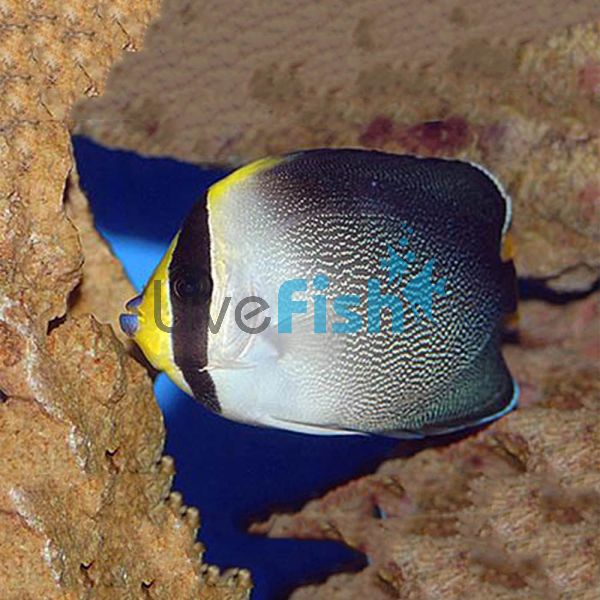Singapore Angelfish - Medium
The Singapore Angelfish is an extremely popular species which is often mistaken for a butterflyfish. Rest assured though that this is an amazing choice for any intermediate aquarium owner.
Singapore Angelfish
The first thing you will notice about this fish is its strikingly blue lips and yellow face. It has a distinctive vertical column running down along its eyes. Yellowtail makes for an interesting contrast with its black body which fades into white closer to its face. All this combined with the wavy line patterning and blue-tinged fins make this an impressive creature to look at.
There are no known differences between the sexes and it is extremely difficult to breed this species in captivity. In the wild Singapore Angelfish will normally start the mating process around an hour before sunset with the male performing elaborate rituals by swimming vertically above the female and hanging motionless waiting for her response.
The Singapore Angelfish although moderately difficult to maintain is well worth the effort and the patience and will become a prized addition to your tank.
These fish are found all over the Indo - West Pacific area and love to inhabit reef areas with plenty of coral between 3 and 15 meters deep. The young are generally found on their own, but as they progress into adulthood they are normally found in pairs that have mated for life.
Tank Recommendations for Singapore Angelfish
The smallest tank size for this species is 380 litres and should already be well established and matured with plenty of algae growth present on the rocks. Make sure that it has plenty of hiding spaces as well as at least one area with plenty of light to stimulate natural algae growth. No specific water movement is required, but bi-weekly water changes are recommended. These fish will do well in a Fish Only With Live Rock tank environment.
Suitable Tank Buddies
These fish are semi-aggressive and as such should be kept with other semi-aggressive fish and well as peaceful ones. They will fight with other fish that look too similar to them so keep them as singles unless housing in an extremely large tank.
Usually Compatible
Good tank buddies for this species could include Blennies, Anglerfish, and Clownfish. Eels, Damselfish, Groupers, and Grunts would also make excellent choices. They should also get along fine with Pufferfish, Lionfish, and Parrotfish. Squirrelfish, Tangs, and Wrasses are perfectly acceptable as well.
Sometime Compatible
Caution should be taken when housing with species of Butterflyfish, especially if they look alike, as they will most probably fight. Batfish, Boxfish, and Filefish may also be problematic. Gobies, Triggerfish, and Dragonets should also be watched carefully. Success can sometimes be had with smaller species of Shark. The Singapore Angelfish has also been known to nip at corals, crustaceans, and invertebrates so choose them wisely.
Rarely Compatible
Keeping with the same and/or other species of large Angelfish will result in aggression. Rays should also be avoided at all costs as they will not get along at all. Smaller more docile species such as Pipefish and Seahorses should not even be considered as they will starve to death in the presence of large angelfish like this one.
Feeding Your Singapore Angelfish
This species is omnivorous and in the wild will feed primarily on algae but will also eat sea sponges and other similar creatures. You will need to provide a varied diet of flake, frozen and dried food, but make sure that it has spirulina added to it. They will also enjoy a chomp on fresh/frozen shredded shrimp along with mysis shrimp. Feed them 3 times a day and only reduce this if your aquarium contains an adequate supply of algae growth for them to graze on.
| Scientific Name | Chaetodontoplus mesoleucus |
|---|---|
| Care Level | Moderate |
| Common Names | The Singapore Angelfish is also known as the Vermiculate Angelfish and the Red Sea Butterflyfish. |
| Diet | Omnivore |
| Fish Family | Pomacanthidae |
| Lifespan (years) | 10 |
| Max. Length (cm) | 18 |
| Min. Tank Volume (l) | 380 |
| Origin | Indo-Pacific |
| Reef Safe | No |
| Sociability | Semi-aggressive |
| Venomous | No |
| Water Conditions | 25 - 28°C, dKH 8-12, pH 8.1-8.4, sg 1.023-1.025 |
| Plant Safe | No |




